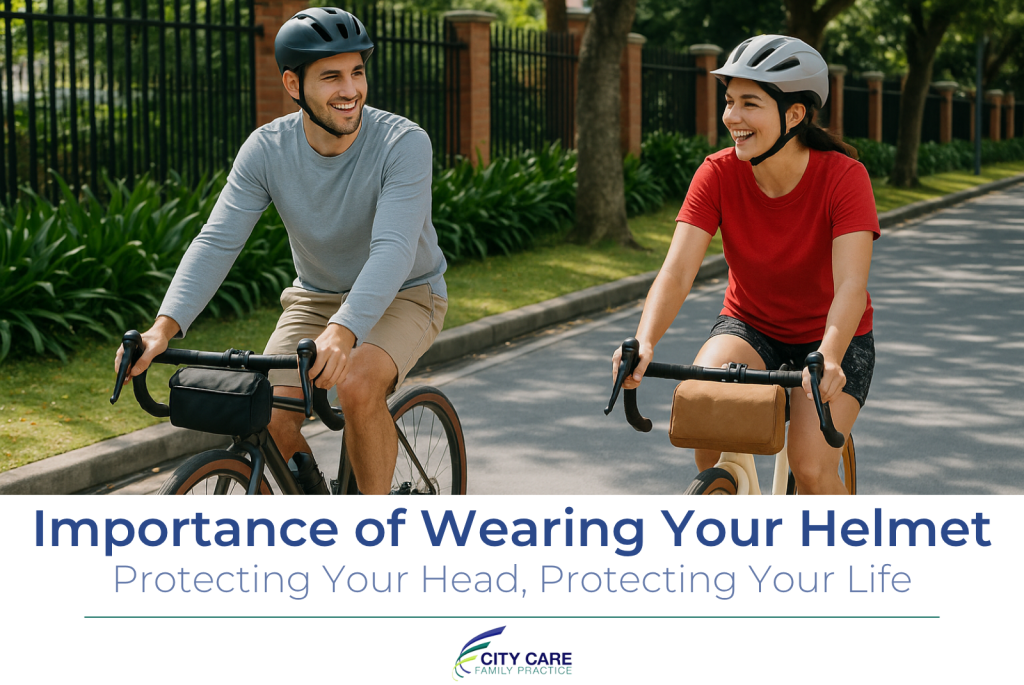
Just the other day, a patient called our office worried about severe headaches that had started after a fall a few weeks earlier. He explained that he had been riding his bike through the city when he swerved to avoid a car, lost his balance, and tumbled onto the sidewalk, bumping his head in the process. Since then, the pain had been getting worse, and he wasn’t sure what to do next.
Our receptionist immediately reached out to one of our providers for guidance. After asking a few follow-up questions about his symptoms and how he was feeling, it became clear that this was something that needed immediate attention. The provider advised him to head straight to the emergency room to be evaluated right away.
Whether you’re biking through Central Park, riding a scooter down Park Avenue, or enjoying weekend rollerblading along the Hudson River Greenway, wearing a helmet is one of the simplest and most effective ways to prevent serious injury. Head trauma from falls and collisions can cause life-altering consequences, and a properly fitted helmet dramatically reduces the risk.
Why Helmet Safety Matters
- Prevents Traumatic Brain Injury (TBI): Helmets absorb impact, reducing the force transmitted to the skull and brain.
- Reduces Facial and Skull Fractures: A sturdy outer shell helps shield your face and skull during a crash.
- Sets a Positive Example: Children are more likely to wear helmets if adults consistently do so.
- Required by Law in Many Situations: NYC regulations mandate helmet use for certain riders, and some shared bike or e-scooter programs require it.
How to Choose and Wear a Helmet Correctly
Helmets aren’t just for looking cool while riding through Central Park! When purchasing one, it’s important to understand the key components that make a helmet effective and safe.
- Fit is Everything: A helmet should be snug but comfortable, sitting level on your head and covering the forehead.
- Check for Certifications: Look for CPSC, Snell, or ASTM labels to ensure safety standards.
- Replace After Impact: Even a single fall can compromise a helmet’s integrity.
- Adjust Straps Properly: The chin strap should be tight enough that only one or two fingers fit between strap and chin.
Comprehensive Q&A
Q: Do helmets really prevent concussions?
A: While no helmet can guarantee prevention of all concussions, it significantly lowers the risk and severity of head injuries.
Q: How often should I replace my helmet?
A: Replace every 5 years or immediately after a crash, even if it looks undamaged.
Q: Are helmets required by law for adult cyclists in New York City?
A: Adults are not legally required, but helmets are strongly recommended and are mandatory for riders of e-bikes and certain delivery cyclists.
Q: What’s the best helmet for children?
A: Choose a helmet certified by CPSC with adjustable straps and multiple sizing pads to grow with your child.
Q: How can I encourage my teen to wear a helmet?
A: Let them pick the style and color, explain the risks, and model good behavior by wearing your own helmet.
Visit City Care Family Practice
Your health and safety are our top priorities. If you experience a head injury or symptoms such as dizziness, confusion, or headache after a fall, seek medical attention promptly.
City Care Family Practice
461 Park Ave South, Fl 9
New York, NY 10016 (at 31st Street)
Phone: (212) 545-1888
Website: https://citycarefamilypractice.com/
Stay Safe. Wear Your Helmet.
A helmet is a simple piece of equipment that can make a life-saving difference. Protect yourself and set an example for others—every ride, every time.
